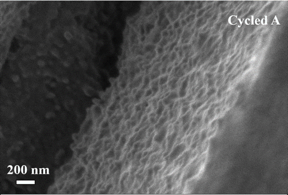Home > Press > Self-standing mesoporous Si film can power lithium-ion batteries Peer-Reviewed Publication
 |
| SEM image of the cross-section of the optimal Si film electrode after cycling.
CREDIT The Authors. |
Abstract:
Battery researchers at the University of Eastern Finland have developed a self-standing mesoporous silicon (Si) film anode for lithium-ion batteries. This film electrode does not need carbon additives and binders to connect particles like typical slurry-based electrodes, but it still exhibits excellent battery performance. The success of this electrode design provides an efficient strategy for achieving high energy density lithium-ion batteries.
Self-standing mesoporous Si film can power lithium-ion batteries Peer-Reviewed Publication
Kuopio, Finland | Posted on April 1st, 2022
The development of high performance lithium-ion batteries has been highly desirable due to their wide applications in portable electronics and in electric and hybrid vehicles. Silicon is the most promising anode material for next-generation lithium-ion batteries due to its high theoretical specific capacity and safe electrochemical potential. However, Si anode suffers from large volume expansion and contraction during cycling that causes electrical contact loss between silicon and other battery components, eventually leading to battery failure.
Battery researchers from all over the world have been dedicating their efforts to improving Si electrode performance, including researchers at the University of Eastern Finland. Using the electrochemical etching method, they developed a self-standing mesoporous Si film anode for lithium-ion batteries. The idea is that the pores of mesoporous silicon can accommodate the volume expansion during cycling, thus leading to stable battery cycling. They systematically investigated the effects of pore characteristics on electrode performance using correlation analysis and uncovered their relationship.
Detailed pore analysis and electrochemical characterization of the Si films were performed to study their correlation. Correlation analysis showed that both reversible specific capacity and initial Coulombic efficiency (ICE) have a strong negative correlation with the porosity and surface area, while the cycling performance is dictated by the film thickness over the pore characteristics. The only positive correlation was found between the long-term cycling stability and the pore diameter. The best Si film anode delivers an ICE of 81.2% and stable cycling for over 450 cycles with a limited specific capacity of 1200 mAh g−1 in half cells.
The study indicates the direction of the porous silicon material for high-performance lithium-ion bateries. More importantly, it provides the researchers in the battery material research, especially Si anode, with a better understanding of the factors involved in evaluating the electrode performance and developing more cost-effective evaluation strategies for battery research.
The research was funded by the Academy of Finland (project number 325495).
####
For more information, please click here
Contacts:
Maj Vuorre
University of Eastern Finland
Office: 358-504-303-880
Expert Contact
Vesa-Pekka Lehto
University of Eastern Finland
Cell: +358403552470
Copyright © University of Eastern Finland
If you have a comment, please Contact us.
Issuers of news releases, not 7th Wave, Inc. or Nanotechnology Now, are solely responsible for the accuracy of the content.
News and information
![]()
Nano therapy for micro-preemies protects lungs, brain in lab study April 1st, 2022
![]()
Scavenger nanoparticles could make fuel cell-powered vehicles a reality April 1st, 2022
Possible Futures
![]()
Nano therapy for micro-preemies protects lungs, brain in lab study April 1st, 2022
![]()
Scavenger nanoparticles could make fuel cell-powered vehicles a reality April 1st, 2022
![]()
Graphene crystals grow better under copper cover April 1st, 2022
Discoveries
![]()
Nano therapy for micro-preemies protects lungs, brain in lab study April 1st, 2022
![]()
Graphene crystals grow better under copper cover April 1st, 2022
![]()
Quantum shock absorbers allow perovskite to exhibit superfluorescence at room temperature April 1st, 2022
Announcements
![]()
Graphene crystals grow better under copper cover April 1st, 2022
![]()
Quantum shock absorbers allow perovskite to exhibit superfluorescence at room temperature April 1st, 2022
![]()
Could quantum technology be New Mexicos next economic boon? Quantum New Mexico Coalition aims to establish state as national hub April 1st, 2022
Interviews/Book Reviews/Essays/Reports/Podcasts/Journals/White papers/Posters
![]()
Nano therapy for micro-preemies protects lungs, brain in lab study April 1st, 2022
![]()
Scavenger nanoparticles could make fuel cell-powered vehicles a reality April 1st, 2022
![]()
Graphene crystals grow better under copper cover April 1st, 2022
![]()
Quantum shock absorbers allow perovskite to exhibit superfluorescence at room temperature April 1st, 2022
Battery Technology/Capacitors/Generators/Piezoelectrics/Thermoelectrics/Energy storage
![]()
Graphene gets enhanced by flashing: Rice process customizes one-, two- or three-element doping for applications March 31st, 2022
![]()
Re-jigged cathode recipe gives new hope to solid-state batteries for electric vehicles March 25th, 2022
![]()
Researchers develop the world’s first power-free frequency tuner using nanomaterials March 18th, 2022
Grants/Sponsored Research/Awards/Scholarships/Gifts/Contests/Honors/Records
![]()
Scavenger nanoparticles could make fuel cell-powered vehicles a reality April 1st, 2022
![]()
Scientists prepare for the worlds smallest race: Nanocar Race II March 18th, 2022










